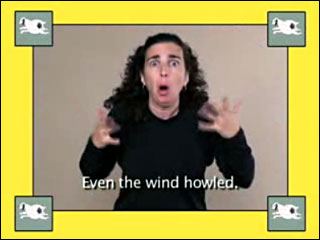BY ALLISON FROST
February 11, 2009
Salem, OR —New children’s books come out everyday, but it’s rare that someone creates an entirely new way of storytelling.
But the creator of a new version of The Princess and the Pea has come up with a book for the hearing-impaired that’s written in both English and American Sign Language. Allison Frost reports.
Creator Laurie Meyer is a long time American Sign Language interpreter.
When she couldn’t find any books in ASL, she decided to create her own — if you can call it a book. It’s really something new.
 ASL Tales: “Once upon a time, there was a prince who lived in a lovely castle.”
ASL Tales: “Once upon a time, there was a prince who lived in a lovely castle.”
The text of the book is in English, and it comes with a companion DVD.
ASL Tales: “But the prince was lonely. . . So he set out on a journey to find a princess.”
What you see on the DVD are rich, colorful illustrations and an expressive ASL signer telling the story visually, while you hear the English narration.
ASL Tales: The prince heard someone knocking at the door. (knocking) When he opened it, he found a princess who was all wet.”
What makes Princess and the Pea so new is the fact that the ASL story is told by a native speaker and not translated.
Laurie Meyer is energetic and passionate about ASL. And she’s completely convinced her books, in the right hands, will make a difference.
Laurie Meyer: “Deaf children are denied this amazing language all the time. 80 percent of deaf kids don’t get access to ASL. AND — huge numbers of hearing children are learning what they think is ASL that isn’t that doesn’t create them being able to talk to deaf people.”
<<Bus sound. . . honk honk. . . >>
Hearing-impaired kids come from all over the state to attend the Oregon School for the Deaf. The K-12 public school in north Salem sprawls across 52 acres. Patti Togioka heads the school.
<<fade bus sound down and out>>
Patti Togioka: “Young deaf children are not getting ASL.”
<<fade in sound of kids from Oregon School for the deaf>>
Togioka says that’s because most deaf kids have hearing parents — many who may have never even met a deaf person before. Some parents are told their kids won’t ever learn to speak if they learn ASL first. Totally untrue, Togioka says.
Patti Togioka: “When they have something they can count on, they feel freer to explore in a second language.”
No one says learning German will make you less able to speak English, Togioka says, and it’s the same with ASL.
Patti Togioka: “Having access to a full complete language gives you the confidence and the linguistic skill to manipulate your second language. We find that with bilingual education; it’s no different with deaf children.”
 Story creator Laurie Meyer says what most hearing people don’t understand is that ASL is not English in sign form. It is truly a language all its own, and like any language has its own vocabulary and grammar.
Story creator Laurie Meyer says what most hearing people don’t understand is that ASL is not English in sign form. It is truly a language all its own, and like any language has its own vocabulary and grammar.
You can’t learn Spanish by memorizing some Spanish words or phrases. And just because you learn a few signs — or even a lot of signs — doesn’t mean you know ASL.
ASL Tales: “The princess asked to come in, and promptly made friends with the dog.”
Try describing a painting using only facial expressions. You can’t do it.
Just like hearing people use facial expressions AND spoken words, Meyer says, deaf people need a third dimension — space.
She says signing isn’t just about the shape you make with your fingers and hands — it’s also the position of your hands and how they move through space that’s crucial.
Meyer says most sign language books get it wrong.
Laurie Meyer: “(The) palm orientation is always wrong, the movement’s always wrong, that’s how I learned it first and then I had to spend a lot of time unlearning everything I learned.”
Since deaf people rely on sight to communicate, instead of hearing — that third dimension of space makes all the difference.
Laurie Meyer: “You cannot learn sign language at all from a two dimensional thing. Try it.”
Susan Mather: “My mother didn’t sign to me but she gave me books. You know, for me, that was key in my educational development, that’s how I acquired English as a second language.”
Susan Mather is a linguistics professor at Gallaudet. It’s the world’s only university devoted completely to hearing-impaired students, and one that’s fully bilingual in both English and ASL.
Mather spoke to us through an ASL interpreter.
 |
| Calypso Tucker and Isolde Strandberg |
Susan Mather: “I think that ASL Tales, with the DVD, is a critical component, both of them together are just a beautiful tool, that families can actually learn together with and enjoy.”
<sound of Calyso Tucker and sister Isolde playing>
6-year-old Calypso Tucker is a student at the Oregon School for the Deaf. Her mom Haley says she loves her bilingual school. She had a visceral response to the Princess and the Pea.
Haley Tucker: “She said, that lady’s deaf, she’s deaf. You know, right away it was, a connection of, a natural language use and she really connected, so it was great. And this one loved it too. . . ”
Isolde: “I do. I like stories.”
Haley Tucker: “Yeah, you like stories.”
Calypo’s 3-year-old sister Isolde can hear. She’s grown up with ASL, so she’s bilingual.
Allison: “And do you sign to talk to your sister?”
Isolde: “Yeah, I do.”
Haley Tucker: (to Isolde): “What else do you say to sister?”
Haley Tucker: “How do you say that”
(Calypso vocalizing) (fade down conversation)
Having a book that reaches both her children would be good enough for parent Haley Tucker. But she also appreciates that Laurie Meyer has updated the fairy tale.
ASL Tales Sound: “It seems you like this Princess,” said the Queen. “I do,” said the Prince. “And she can read the biggest, heaviest books,” said the Prince.
In addition to American Sign Language and English, Princess and the Pea is recorded in ASL and French, Spanish, Mandarin, Thai and Vietnamese.
Creator Laurie Meyer will soon have an entire series of books coming out which she calls ASL Tales.
© 2009 OPB


 ASL Tales: “Once upon a time, there was a prince who lived in a lovely castle.”
ASL Tales: “Once upon a time, there was a prince who lived in a lovely castle.” Story creator Laurie Meyer says what most hearing people don’t understand is that ASL is not English in sign form. It is truly a language all its own, and like any language has its own vocabulary and grammar.
Story creator Laurie Meyer says what most hearing people don’t understand is that ASL is not English in sign form. It is truly a language all its own, and like any language has its own vocabulary and grammar.
Recent Comments